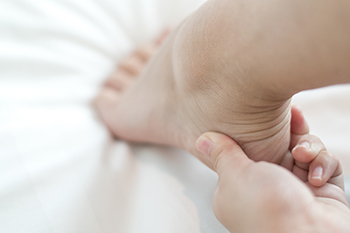
The foot condition called Sever’s disease affects children and young teenagers. The medical term for this ailment is calcaneal apophysitis which affects the growth plate in the heel. This can happen when the heel bone grows faster than the connecting muscles and tendons, causing the tendons to pull on the growth plate. The type of children that Sever’s disease affects most are those who frequently participate in running and jumping activities. A common symptom of this condition is heel pain and it can be severe. It is generally worse after arising in the morning and relief may start with temporarily stopping the activity that caused the condition. Additional symptoms include swelling in the heel and surrounding areas, and the pain may make it difficult to walk. An effective method to diagnose Sever’s disease is known as the squeeze test. This is accomplished when the inside and the outside of the heel are squeezed at the same time and pain is present. Treatment may involve performing specific stretches and exercises that can benefit the heel. If your child has heel pain, please confer with a podiatrist who can diagnose Sever’s disease and offer you effective treatment options.
Sever's disease often occurs in children and teens. If your child is experiencing foot or ankle pain, see Ali Davis, DPM from The Foot Clinic. Our doctor can treat your child’s foot and ankle needs.
Sever’s Disease
Sever’s disease is also known as calcaneal apophysitis, which is a medical condition that causes heel pain I none or both feet. The disease is known to affect children between the ages of 8 and 14.
Sever’s disease occurs when part of the child’s heel known as the growth plate (calcaneal epiphysis) is attached to the Achilles tendon. This area can suffer injury when the muscles and tendons of the growing foot do not keep pace with bone growth. Therefore, the constant pain which one experiences at the back of the heel will make the child unable to put any weight on the heel. The child is then forced to walk on their toes.
Symptoms
Acute pain – Pain associated with Sever’s disease is usually felt in the heel when the child engages in physical activity such as walking, jumping and or running.
Highly active – Children who are very active are among the most susceptible in experiencing Sever’s disease, because of the stress and tension placed on their feet.
If you have any questions, please feel free to contact our office located in Overland Park, KS . We offer the newest diagnostic and treatment technologies for all your foot and ankle injuries.
